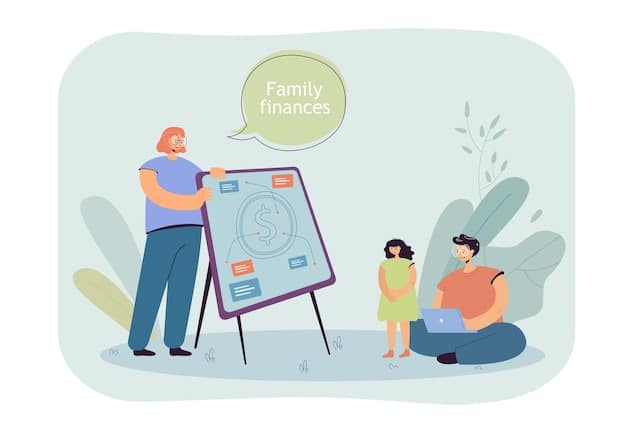Mastering the 2025 FAFSA Changes: Your Guide to Max Financial Aid

Understanding the New Changes to the FAFSA: How to Maximize Your Financial Aid in 2025 involves navigating streamlined processes, expanded Pell Grant eligibility, and revised needs analysis, all aimed at making college more accessible and affordable for students and their families.
Navigating the world of financial aid can feel overwhelming, especially with updates on the horizon. This guide will help you with Understanding the New Changes to the FAFSA: How to Maximize Your Financial Aid in 2025, ensuring you’re prepared to secure the best possible outcome for your college journey.
Key Updates to the 2025 FAFSA: What You Need to Know
The Free Application for Federal Student Aid (FAFSA) is undergoing significant changes aimed at simplifying the application process and expanding access to financial aid. Let’s delve into the most crucial updates for the 2025-2026 academic year.
Understanding the New Changes to the FAFSA: How to Maximize Your Financial Aid in 2025 requires a proactive approach. These updates aim to make the process smoother and allow more students to qualify for aid.
Simplified Application Process
One of the most significant changes is the streamlined application process. The number of questions has been reduced, making it faster and easier to complete the FAFSA.
Expanded Pell Grant Eligibility
The updates include expanded eligibility for Pell Grants, meaning more students from low-income backgrounds can receive federal aid to help cover tuition costs.

These changes combined can drastically reduce the time to complete the FAFSA and make it easier for you to gain access to the benefits you need. The simplified application and expanded Pell Grant eligibility has made college affordable for countless individuals. Here are some examples of how these changes benefit you:
- Reduced Question Count: Reduces stress and effort required to complete the form.
- Improved User Experience: A more intuitive interface makes it easier to navigate the FAFSA.
- Increased Pell Grant Access: More low-income students qualify for federal aid.
- Greater Financial Access: Ultimately results in more substantial financial aid packages.
In summary, the key updates to the 2025 FAFSA focus on simplification and expansion of eligibility, aiming to make college more accessible and affordable. Understanding the New Changes to the FAFSA: How to Maximize Your Financial Aid in 2025 means being aware of these updates and how they can benefit you.
Navigating the New FAFSA Form: A Step-by-Step Guide
Completing the FAFSA form can seem daunting, but it’s a crucial step in securing financial aid. This section provides a step-by-step guide to help you navigate the new form effectively, ensuring you don’t miss any important details.
Understanding the New Changes to the FAFSA: How to Maximize Your Financial Aid in 2025 also means knowing the exact processes and timelines to stay within regulations. The most important thing is to follow the guide for each step and to keep an eye on deadlines.
Creating an FSA ID
Before you start the FAFSA, you’ll need to create a Federal Student Aid (FSA) ID. This ID serves as your electronic signature and provides access to the FAFSA form online.
Gathering Necessary Documents
Collect all necessary documents, including your Social Security number, tax returns (if applicable), and bank statements. Having these documents ready will make the application process smoother.
Some important documents required to complete the FAFSA include:
- Social Security Number: Ensures proper identification on the application.
- Tax Returns: Provides income information for accurate aid calculation.
- Bank Statements: Verifies assets for a comprehensive financial overview.
- W-2 Forms: Necessary to report earnings accurately.
In short, successfully navigating the new FAFSA form involves creating an FSA ID, gathering all necessary documents, and completing the form accurately. Understanding the New Changes to the FAFSA: How to Maximize Your Financial Aid in 2025 needs time and appropriate planning ahead of time.
Understanding the Student Aid Index (SAI)
The Expected Family Contribution (EFC) has been replaced by the Student Aid Index (SAI). This new metric determines your eligibility for federal student aid. In this section we will understand what SAI is used for
Understanding the New Changes to the FAFSA: How to Maximize Your Financial Aid in 2025 requires you to truly understand the impact of SAI in eligibility. Understanding how the SAI is calculated will tell you what is needed to maximize financial aid.
How SAI is Calculated
The SAI considers factors such as income, assets, and family size to determine the amount a student and their family are expected to contribute to college costs. The new changes will focus even more on asset and income.
Impact of SAI on Financial Aid
A lower SAI generally means a student is eligible for more financial aid, including Pell Grants and other federal programs. With a higher SAI, eligibility is heavily reduced.
Knowing how the SAI impacts overall financial aid can go along way. Here are some of the impacts of SAI on financial aid:
- Lower SAI: Increased eligibility for Pell Grants and federal programs.
- Higher SAI: Decreased eligibility for aid, requiring alternative funding sources.
- Asset Consideration: Highlights the importance of strategic asset management.
- Income Reporting: Accurate income reporting is crucial for SAI calculation.
Knowing the difference on how to manage and optimize the SAI is critical to understand how financial aid works for your own benefit. In conclusion, Understanding the New Changes to the FAFSA: How to Maximize Your Financial Aid in 2025 involves knowing how the SAI is calculated and its impact on your financial aid eligibility.

Maximizing Your Financial Aid: Tips and Strategies
Securing the maximum amount of financial aid requires careful planning and strategic decision-making. This section provides practical tips and strategies to help you get the most out of the FAFSA.
Understanding the New Changes to the FAFSA: How to Maximize Your Financial Aid in 2025 and tips and strategies is a smart way to plan for the future. These can help you find the support you need to attend college.
Applying Early
Submit your FAFSA as early as possible, as some aid programs have limited funding. Early applications often receive priority consideration.
Accurate Information
Ensure all information provided on the FAFSA is accurate and up-to-date. Errors or inconsistencies can delay or reduce your aid eligibility.
Applying early and providing accurate information can increase the chance of aid eligibility. Some of tips for maximizing efficiency are:
- Early Submission: Increases the likelihood of receiving aid from limited programs.
- Regular Updates: Keep your FAFSA up-to-date, if things change during the semester the FAFSA is responsible for.
- Double-Check Entries: Reduces errors and delays in processing.
- Professional Review: If possible it is recommended to have a professional to review this.
To summarize, maximizing your financial aid involves applying early, providing accurate information, and managing your assets strategically. Understanding the New Changes to the FAFSA: How to Maximize Your Financial Aid in 2025 is key to ensuring you secure the maximum amount of aid available to you.
Changes to Dependency Status: Who is Considered a Dependent?
Dependency status is a critical factor in determining financial aid eligibility. Understanding who is considered a dependent can significantly impact your SAI and the amount of aid you receive. Let’s examine the changes on dependency status
Understanding the New Changes to the FAFSA: How to Maximize Your Financial Aid in 2025 by looking at Dependency status and how to maximize the benefits can improve college financial planning. It is important to know that dependent requirements differ greatly from the past.
Criteria for Dependency
The FAFSA considers various factors to determine dependency status, including age, marital status, and whether the student provides more than half of their own support.
Impact on SAI
Dependent students are required to include their parents’ financial information on the FAFSA, which can impact their SAI and overall aid eligibility.
For a dependent the eligibility of both the student and the parent are considered. Here area some things that should be considered:
- Age Verification: Dependency is heavily linked to age, if under a certain age, most likely a student is dependent.
- Income Thresholds: The income needs to be verifiable for the dependency status.
- Living Situation: The dependency also considers the domestic aspect of living with parents.
The dependency status is calculated based on a number of different standards. With proper knowledge and research it can truly make a difference. In conclusion, understanding dependency status and its impact on financial aid eligibility is crucial for maximizing your benefits. Understanding the New Changes to the FAFSA: How to Maximize Your Financial Aid in 2025 includes recognizing the criteria for dependency and how it affects your SAI.
Resources and Support for Navigating the FAFSA
Navigating the FAFSA can be challenging, but numerous resources and support systems are available to help you through the process. This section highlights key resources that can provide guidance and assistance as you complete your application.
Understanding the New Changes to the FAFSA: How to Maximize Your Financial Aid in 2025 through various resources and support will help you successfully navigate college admissions and financial aid. College does not have to be difficult to achieve, let’s explore some resources.
Federal Student Aid Website
The Federal Student Aid website offers comprehensive information about the FAFSA, including instructions, deadlines, and FAQs.
College Financial Aid Offices
College financial aid offices provide personalized support and guidance to students and families, helping them understand their aid options and navigate the application process.
Taking advantage of multiple resources can greatly speed up and simplify the process. Some important resources to take advantage of are:
- FAFSA Website: Contains guidelines and instructions on how to fill out the application.
- Financial Aid Offices: It is always good to ask the experts regarding aid eligibility.
- Educational Workshops: These offer hands-on guides on how to fill out the FAFSA.
Overall, using the available resources and support systems is essential for successfully navigating the FAFSA. Understanding the New Changes to the FAFSA: How to Maximize Your Financial Aid in 2025 requires leveraging these resources to gain clarity and confidence in your application.
| Key Point | Brief Description |
|---|---|
| 📝 Simplified Application | Fewer questions make the form easier to complete. |
| 💰 Expanded Pell Grants | More students from low-income backgrounds are eligible. |
| ✅ Student Aid Index (SAI) | Replaces EFC; impacts aid eligibility. |
| 📅 Apply Early | Submit FAFSA as soon as it opens for priority consideration. |
What are the most significant changes to the 2025 FAFSA?
▼
The 2025 FAFSA includes a simplified application process with fewer questions, expanded Pell Grant eligibility, and the replacement of the Expected Family Contribution (EFC) with the Student Aid Index (SAI).
What is the Student Aid Index (SAI)?
▼
The Student Aid Index (SAI) is a new metric used to determine a student’s eligibility for financial aid. It considers factors like income, assets, and family size to calculate the amount a student and their family are expected to contribute to college costs.
How can I maximize my financial aid?
▼
To maximize your financial aid, submit your FAFSA early, provide accurate information, and manage your assets strategically. Also, be sure to check for any state-specific or institutional aid programs you may be eligible for.
What documents do I need to complete the FAFSA?
▼





